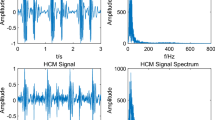Abstract
A normal/abnormal heart sound identification method was put forward in the paper. The wavelet packet energy features of the heart sounds were extracted in a large database of 1136 recordings and xgboost algorithm was used as the classifier. The feature importance is also evaluated and analyzed. Top 3, 6, 9 and 12 features were used to classify the heart sounds. Experimental results showed that the proposed algorithm can identify the normal and abnormal heart sounds effectively. And the result used top 9 features was as good as that of all features, which can reduce almost half of computation.
Access this chapter
Tax calculation will be finalised at checkout
Purchases are for personal use only
Similar content being viewed by others
References
Plett, M.I.: Ultrasonic arterial vibrometry with wavelet based detection and estimation. Ph.D. thesis, University of Washington (2000)
Hanbay, D.: An expert system based on least square support vector machines for diagnosis of the valvular heart disease. Expert Syst. Appl. 36, 4232–4238 (2009)
Wang, Y., Li, W., et al.: Identification of the normal and abnormal heart sounds using wavelet-time entropy features based on OMS-WPD. Future Gener. Comput. Syst. 37, 488–495 (2014)
Sun, S.: An innovative intelligent system based on automatic diagnostic feature extraction for diagnosing heart diseases. Knowl. Based Syst. 75, 224–238 (2015)
Chen, X., Ma, Y., et al.: Research on heart sound identification technology. Sci. Chin. Inf. Sci. 55(2), 281–292 (2012)
Sengur, A.: An expert system based on linear discriminant analysis and adaptive neuro-fuzzy inference system to diagnosis heart valve diseases. Expert Syst. Appl. 35, 214–222 (2008)
Avci, E., Turkoglu, I.: An intelligent diagnosis system based on principle component analysis and ANFIS for the heart valve diseases. Expert Syst. Appl. 36, 2873–2878 (2009)
Das, R., Turkoglu, I., et al.: Diagnosis of valvular heart disease through neural networks ensembles. Comput. Methods Programs Biomed. 93, 185–191 (2009)
Harun, U.: Adaptive neuro-fuzzy inference system for diagnosis of the heart valve diseases using wavelet transform with entropy. Neural Comput. Appl. 21(7), 1617–1628 (2012)
Chen, T.H., Han, L.Q., et al.: Research of denoising method of heart sound signals based on wavelet transform. Comput. Simul. 12(27), 401–405 (2010)
Bhatnagar, G., Wu, J., et al.: Fractional dual tree complex wavelet transform and its application to biometric security during communication and transmission. Future Gener. Comput. Syst. 28(1), 254–267 (2012)
Hou, Y., Li, T.: Improvement of BP neural network by LM optimizing algorithm in target identification. J. Detect. Control 30(1), 53–58 (2008). (in Chinese)
Cheng, X., Yang, H.: Analysis and comparison of five kinds of wavelet in processing heart sound signal. J. Nanjing Univ. Posts Telecommun. (Nat. Sci. Ed.) 35(1), 38–46 (2015). (in Chinese)
Friedman, J.H.: Stochastic gradient boosting. Comput. Stat. Data Anal. 38, 367–378 (2002)
Chen, T., Guestrin, C.: Xgboost: a scalable tree boosting system. In: ACM International Conference on Knowledge Discovery and Data Mining (2016)
Zheng, H., Yuan, J., Long, C.: Short-term load forecasting using EMD-LSTM neural networks with a Xgboost algorithm for feature importance evaluation. Energies 10, 1168–1188 (2017)
Acknowledgements
This work was supported in part by the National Natural Science Foundation of China under Grant Nos. 61601081, 61471081; Fundamental Research Funds for the Central Universities under Grant Nos. DC201501056, DCPY2016008, DUT15QY60, DUT16QY13; Dalian Youth Technology Star Project Supporting Plan under Grant No. 2015R091.
Author information
Authors and Affiliations
Corresponding author
Editor information
Editors and Affiliations
Rights and permissions
Copyright information
© 2018 Springer Nature Switzerland AG
About this paper
Cite this paper
Li, T., Chen, Xr., Tang, H., Xu, Xk. (2018). Identification of the Normal/Abnormal Heart Sounds Based on Energy Features and Xgboost. In: Zhou, J., et al. Biometric Recognition. CCBR 2018. Lecture Notes in Computer Science(), vol 10996. Springer, Cham. https://doi.org/10.1007/978-3-319-97909-0_57
Download citation
DOI: https://doi.org/10.1007/978-3-319-97909-0_57
Published:
Publisher Name: Springer, Cham
Print ISBN: 978-3-319-97908-3
Online ISBN: 978-3-319-97909-0
eBook Packages: Computer ScienceComputer Science (R0)




